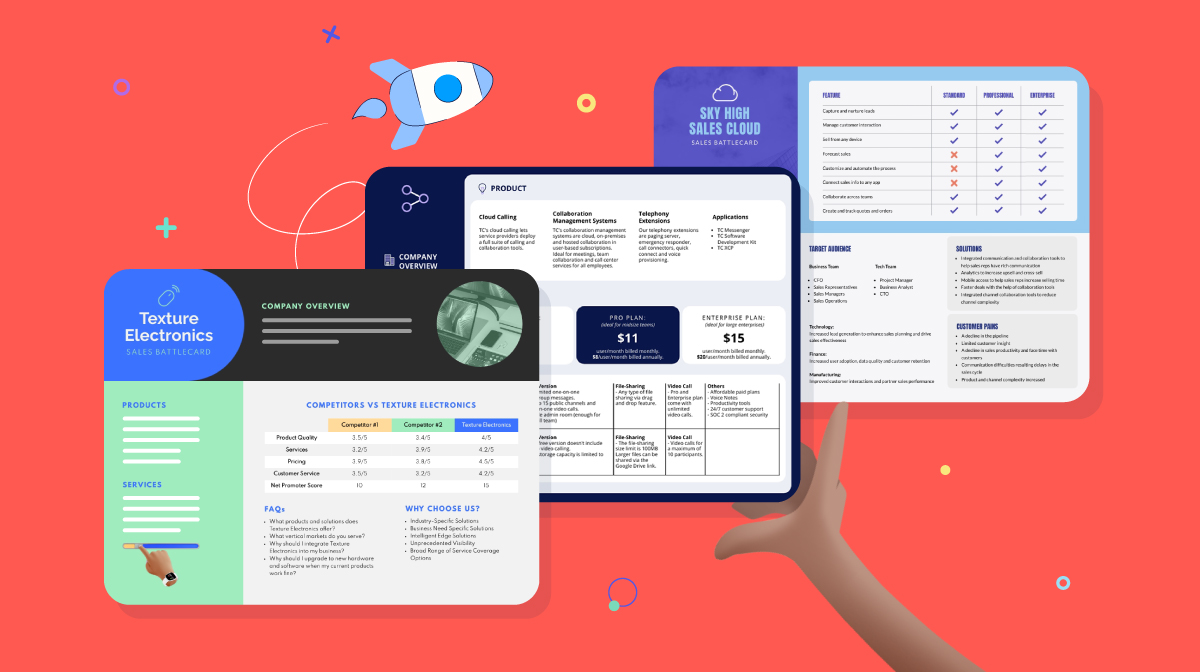Competitor Battle Cards: Enhancing Your Sales Strategy

In the modern business environment, understanding the competition is paramount to success. As businesses strive to stand out, having precise tools and strategies is crucial. One tool that has become indispensable for sales teams is the competitor battle card.
Interestingly, a 2021 industry survey highlighted that 71% of businesses say these sales tools have helped them increase their win rate with customers! This statistic underscores the significance of such tools. Let’s delve deeper into the specifics.
So What’s A Competitor Battle Card
A competitor battle card is a concise document or digital reference that aggregates crucial information about competitors. There is a sizable list of essential information, but its contents typically include:
Company Profile: A brief overview, including the company’s history and size.
Product Details: Features, benefits, and possible areas of improvement.
Pricing Overview: Their general pricing strategy and any available promotions.
Sales Approach: Commonly used sales tactics and potential objections raised by customers.
Customer Feedback: Reviews, testimonials, and common criticisms.
Market Position: Insights into their standing in the market and their target customer base.
The primary aim of these cards is to provide sales teams with immediate insights, aiding them in positioning their offerings effectively during sales engagements.
The Value of Battle Cards in Sales
Informed Decision Making: An informed sales rep is better positioned to respond to customer queries and objections, especially those relating to competitors.
Boosting Confidence: Having structured and relevant information at one’s disposal naturally enhances confidence, leading to more persuasive sales conversations.
Saving Time: Sales representatives can skip the recurring task of on-the-spot research for each competitor encounter, thereby focusing more on improving their sales approach.
Ensuring Consistent Messaging: With battle cards, businesses can ensure that their entire sales team has a unified understanding of competitors, leading to a consistent message during client interactions.
Crafting Effective Competitor Battle Cards
To maximize the utility of battle cards, consider these steps:
Thorough Research: Start by collecting comprehensive data on competitors. This could be from their websites, customer reviews, sales literature, and third-party analyses.
Engage with Sales Teams: Sales representatives often have firsthand insights into competitors’ tactics and common customer objections. Their input can be invaluable.
Prioritize Visuals: A useful battle card isn’t a lengthy report. Incorporate graphs, charts, and icons to make information easily digestible.
Frequent Updates: Given that market dynamics can shift rapidly, it’s imperative to update battle cards regularly to maintain their relevance.
Easy Accessibility: Whether through a digital tool, mobile app, or a physical reference sheet, ensure that battle cards are readily available for sales reps.
For a more in-depth explanation, please consult this guide about battle cards and how they fit into a wider competitive intelligence plan.
Common Mistakes to Avoid
While battle cards can be powerful, there are potential missteps:
Information Overload: Battle cards should be concise. Overloading them with excessive information can defeat their purpose.
Negative Focus: Highlighting a competitor’s weaknesses is essential, but it’s equally important to focus on your strengths and positive differentiators.
Infrequent Updates: An outdated battle card can lead to misinformation, which might be counterproductive. Ensure there’s a process in place for regular updates.
Conclusion
The introduction and utilization of competitor battle cards underscore a pivotal shift in contemporary sales strategy. These cards, concise in design but rich in insight, are more than just sales tools. They are symbolic of an organization’s commitment to staying informed, agile, and customer-centric. By synthesizing market realities and competitive standings, battle cards ensure that businesses don’t merely react to market shifts but proactively steer their strategies accordingly. In an ever-evolving marketplace, such preparedness and foresight are invaluable, elevating not just sales outcomes but the broader business approach.

